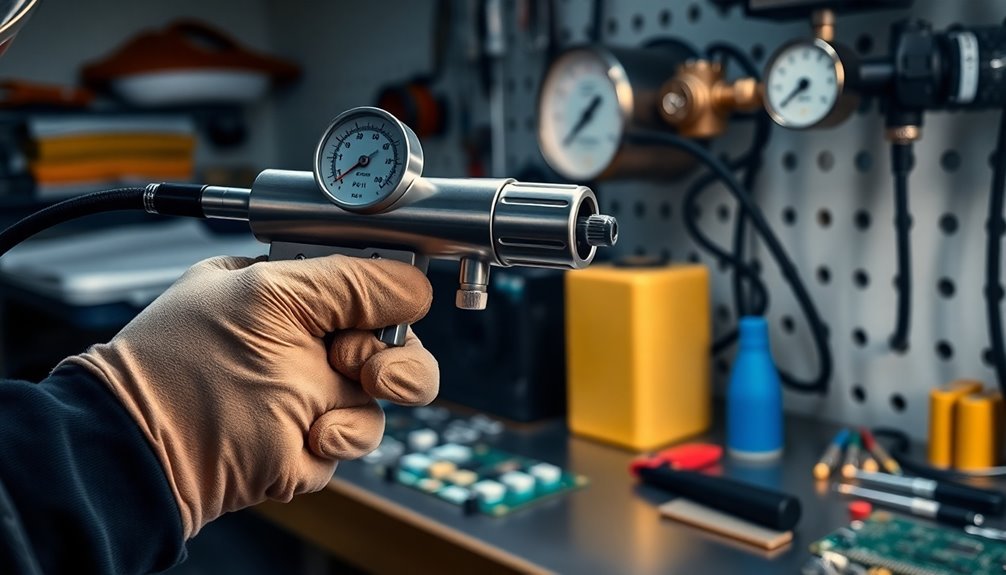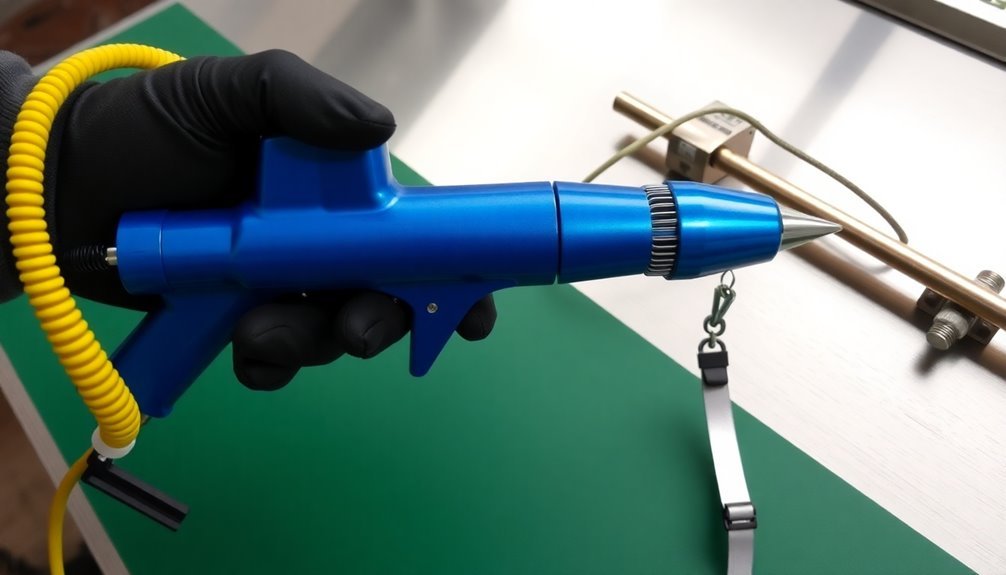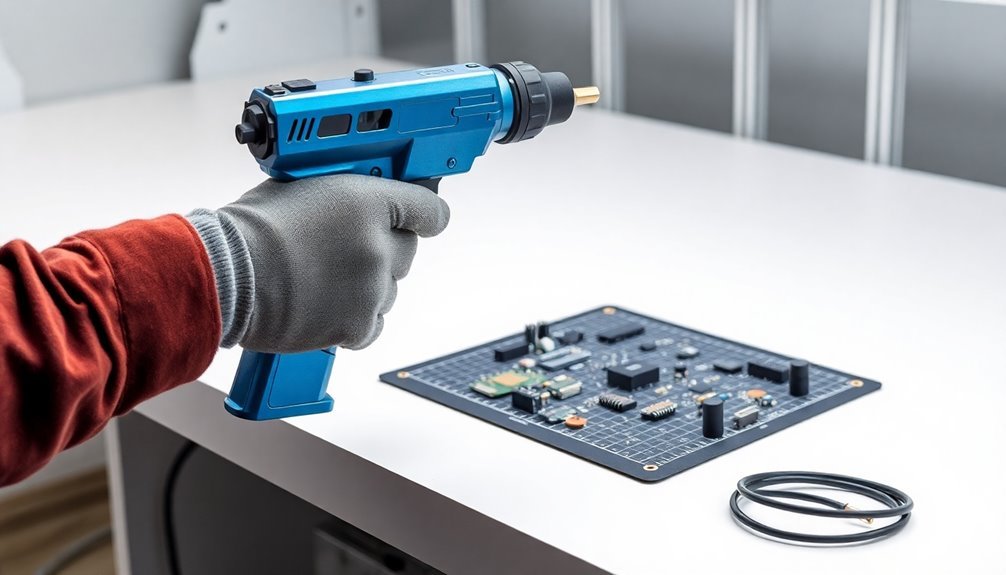Protect yourself while using an ionizing air gun by following these three essential safety tips. First, maintain an ideal distance of 6 inches from the surface and keep air pressure between 30-40 psi to prevent damage and guarantee effective decontamination. Second, install a 2-micron coalescing filter in your air supply system to capture harmful particles and extend your equipment's life. Third, always verify proper grounding connections using a three-prong plug and maintain ground resistance below 100 Ω to prevent electrical hazards. Understanding these fundamentals will help you master additional safety protocols for ionizing air gun operation.
Proper Distance and Pressure Settings

Operating an ionizing air gun requires precise distance and pressure control for ideal results.
You'll achieve the most effective static neutralization by maintaining a distance of 2 to 12 inches from the surface you're cleaning, with 6 inches being the best range in most cases. If you position the gun too far from the target, you'll notice a significant decrease in performance.
For pressure settings, you'll want to keep your air pressure between 30-40 psi for most decontamination tasks. While the gun can handle up to 65 psi, there's usually no benefit to using higher pressures, and it may create unnecessary safety risks. The corona discharge principle ensures efficient ionization at recommended pressure levels. The unit's 12 cfm consumption helps maintain consistent performance during extended cleaning sessions.
You'll need to adjust both distance and pressure based on your specific application and material type.
To maintain peak performance, you'll need to balance these settings carefully. The effectiveness of your static neutralization depends on finding the right combination of distance and pressure.
Remember to check your pressure regulator settings regularly and keep the gun properly maintained. If you're working with different materials, you may need to make minor adjustments to achieve the best results.
Filtered Air Supply Requirements
While distance and pressure settings are essential operational factors, your ionizing air gun's performance heavily depends on clean air supply. You'll need to install a 2-micron coalescing filter or better upstream of your gun console to guarantee superior air quality.
The console's internal filter captures particles down to 0.008 microns, but pre-filtering helps extend its life and effectiveness.
Your compressed air system should maintain pressure between 25-65 psi and deliver clean, dry air free from moisture and contaminants. Install a Finite Filter Grade 10 Media system to remove substantial amounts of particles and aerosols before they reach your gun.
You'll also want to check your air supply lines regularly for leaks or blockages that could compromise performance.
Don't forget to monitor your operating environment for dust and debris that could contaminate the nozzle. Keep your work area well-ventilated to prevent ozone buildup, and implement protective measures for nearby equipment.
Remember to inspect your filters routinely and replace them as needed – this maintenance is vital for maintaining your ionizer's static-neutralizing capabilities and preventing system damage from contaminated air.
Grounding and Static Protection

Every ionizing air gun requires proper grounding and static protection measures to assure safe operation and prevent electrical hazards.
You'll need to connect your unit to a power supply using a three-prong grounding plug and confirm the ground terminal has a resistance of 100 Ω or less. Never defeat or bypass the electrical ground, as this can lead to dangerous situations and product malfunction.
To effectively protect against static discharge, you'll need to follow ESD Association standards, particularly ANSI/ESD Standard STM3.1-2006.
When using the ionizing air gun, maintain proper distance and air pressure to achieve ideal static neutralization. This helps prevent damage to sensitive electronic components and assures safe handling of static-prone materials. The titanium emitter tip provides long-lasting corrosion resistance for sustained safety performance.
Don't operate the unit without confirming proper grounding connections first.
Remember that high voltage is applied to the emitters, so you should never touch them or allow foreign objects to enter the nozzle.
You'll also need to wear safety goggles to protect yourself from any debris or splashed substances.
Frequently Asked Questions
How Often Should the Ionizing Air Gun's Nozzle Tip Be Cleaned?
You should clean your ionizing air gun's nozzle tip every month, but check it regularly for debris buildup. If you notice the tip isn't sharp anymore, it's time to clean it with IPA solution.
Can Ionizing Air Guns Be Used Safely Around Sensitive Electronic Screens?
Yes, you can safely use ionizing air guns around electronic screens since they're designed to neutralize static charges without causing damage. Just maintain proper distance, use recommended pressure, and don't direct airflow too closely.
What Is the Typical Lifespan of an Ionizing Air Gun?
You'll typically get 5+ years from your ionizing air gun, or about 10,000 operating hours when used 8 hours daily. With proper maintenance and careful handling, you can extend its lifespan considerably.
Are There Specific Storage Requirements When Not Using the Gun?
You'll need to store your ionizing air gun in a dry area between -10°C to 50°C and 20-90% humidity. Avoid direct sunlight, corrosive gases, and electromagnetic interference. Don't expose it to sudden temperature changes.
Can Multiple Operators Share the Same Ionizing Air Gun Safely?
You shouldn't share ionizing air guns simultaneously between operators. It's safer for each person to have their own gun to prevent electrical hazards and guarantee proper control over operation and maintenance.
In Summary
You'll find that following these ionizing air gun safety tips helps protect both equipment and personnel. By maintaining proper distance and pressure settings, using filtered air supplies, and implementing proper grounding measures, you're creating a safer work environment. Remember, these aren't just guidelines – they're essential practices that'll help prevent damage from ESD and guarantee your ionizing air gun operates safely and effectively.





Leave a Reply